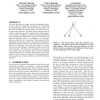Free Online Productivity Tools
i2Speak
i2Symbol
i2OCR
iTex2Img
iWeb2Print
iWeb2Shot
i2Type
iPdf2Split
iPdf2Merge
i2Bopomofo
i2Arabic
i2Style
i2Image
i2PDF
iLatex2Rtf
Sci2ools
95
Voted
ATAL
2006
Springer
2006
Springer
Learning a common language through an emergent interaction topology
We study the effects of various emergent topologies of interaction on the rate of language convergence in a population of communicating agents. The agents generate, parse, and learn the meanings of sentences from each other using recurrent neural networks. An agent chooses another agent to interact with and learn from, based on the second agent's fitness. Fitness is defined to include a frequency-dependent term capturing the approximate number of interactions an agent has had with others--its "popularity" as a linguistic partner, which in turn is a measure of the proportion of the population which it has taught. This method of frequencydependent selection is based on our earlier Noisy Preferential Attachment algorithm, which has been shown to produce various network topologies, including scale-free and smallworld networks. We show that convergence occurs much more quickly with this strategy than it does for uniformly random interactions. In addition, this strategy more ...
ATAL 2006 | Intelligent Agents | Noisy Preferential Attachment | Recurrent Neural Networks | Various Emergent Topologies |
Related Content
| Added | 20 Aug 2010 |
| Updated | 20 Aug 2010 |
| Type | Conference |
| Year | 2006 |
| Where | ATAL |
| Authors | Samarth Swarup, Kiran Lakkaraju, Les Gasser |
Comments (0)

